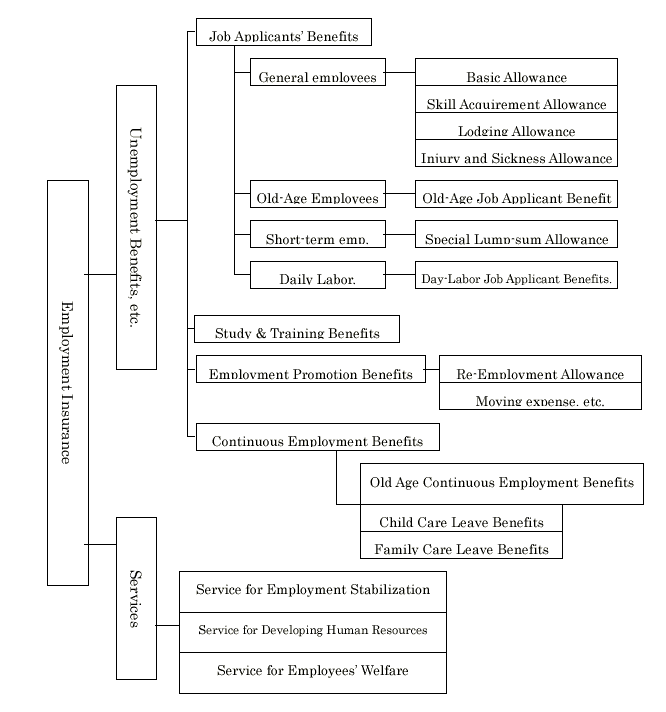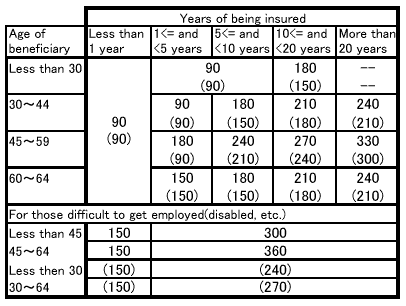
Japan uses the term "Labor Insurance" to mean both the Labor Accident Insurance and the Employment Insurance. The two are independent schemes, but in some respects, such as the collection of the premiums, are treated together. In this Chapter, the focus of the discussion is the Employment Insurance.
Employment Insurance has two functions. One is to provide employees cash benefit in case he/she loses the job. The other is to support employers to prevent them from laying off their employees. The former is called the Unemployment Benefits, and the latter consists of three components, namely: Services for employment stabilization, Services for developing human resources, and Services for employees' welfare. The Unemployment Benefits also include a variety of benefits such as the Job Applicants' Benefits, the Study and Training Benefits, and the Employment Continuation Benefits. The entire scheme is shown in Fig. 6.1.
This is the most commonly referred to as the "Unemployment Benefits". For general employees, it is necessary to have been insured for at least 6 months within one year prior to leaving the job. The duration of the benefits ranges according to the age of the beneficiary and the years of being insured. Since April 2001, the duration of the benefits also depends on the reason of the unemployment, i.e. whether the termination was voluntary (including retirees) or involuntary and without enough time period to arrange re-employment (due to lay-off or bankruptcy of the firm). The Tables 6.1 to 6.3 show the number of days for each kind of recipients.
2. Old Age Continuous Employment BenefitsThis is a scheme for old employees who are between ages 60 and 65 and continue to work at a salary lower than 85% of their salary at age 60. They have to be insured for at least 5 years before receiving the benefit.
Fig. 6.1 Employment Insurance

Table 6.1 Duration of Basic Allowance (General Employees) (unit:days)

Data is effective starting April 1, 2001.
Table 6.2 Duration of Basic Allowance (Involuntary terminated Employees) (unit:days)

* numbers in ( ) are for part-time workers
Data is effective starting April 1, 2001.
Table 6.3 Duration of Old-Age Job Applicant Benefit (unit:days)

Partly due to high unemployment, and partly due to changing employment preferences (both by employees and employers), the number of part-time and temporary workers is rising, especially among young and women. Many of them do not or cannot participate in the Employment Insurance. This is due to the system's underlying concept that the Employment Insurance is security for livelihood for those who make their living with the wages received for their own labor, at the time they lose their jobs.
In response to the changing job market, the 2001 Reform of the Employment Insurance abolished some criteria for part-time and temporary workers to subscribe: the main one of them is the yearly income threshold (\900,000/year). Now part-time or temporary workers working at least 20 hours per week, and works (or sent to work from temp agency) at a same workplace for more than 1 year are eligible to subscribe to the Employment Insurance.
Now a legendary low unemployment rate until the 1980's had left a healthy financial balance of the Employment Insurance, and with this surplus, the system was extended to include services to prevent a lay-off and measures for the old age continuous employees. However, a rapid increase of the unemployment since the 90's has resulted the financial balance of the system to turn into red. The 2001 Reform has tackled the problem in some respects by separating the recipient of the Insurance by reasons of the termination. The effects of the Reforms are yet to be seen.
2. Treatment of elderly employeesHowever, the current system still favors old age employees in many respects (For example, the Old Age Continuous Employment Benefits and the insured period categorization of the Unemployment Benefits). The assumption of the Employment Insurance was that young people are hired easily and will continue to work full-time for the entire duration of their career. Some researchers believe these schemes distort the labour market. The treatment of old age employees must be re-examined closely in relation with the labour market and also other social security systems such as pensions.